
Google Drive Review 2025: Only for Google Fans?
If you have an Android phone or use Gmail, you're already using Google Drive. But Google's cloud storage isn't just great for your photos and emails - you can organize all types of documents, share files with coworkers, or manage entire projects in the cloud. So how does Google Drive compare to other cloud storage options?
We thoroughly tested Google Drive and will show you why Google remains the king of convenience - even if it comes at the cost of privacy.
Google Drive* is a cloud storage service from Google. It stores your files online and syncs them across all your devices, so you can access them anytime. You can upload documents, photos, videos, and other files and edit them from anywhere.
Google Drive comes with every Google account and is free to use. You get 15 GB of storage space by default, which is shared with other Google services like Gmail and Google Photos.
One of Google Drive's biggest strengths is how well it works with other Google services like Docs, Sheets, or Slides: You can create documents directly in Google Drive, share them with others, and work together in real-time.
Basically, Google Drive works like any other cloud storage. What makes it special - both good and bad - you'll find out in our review.
For more information about how it works and a guide to Google Drive, check here:
Google Drive Review
User-friendly interface
Whether on the web, PC, or smartphone: Google Drive is easy to use across all devices and accessible for users of all experience levels.Seamless integration with Google tools
Thanks to its connection with other Google solutions like Docs, Sheets, or Slides, Google Drive is a great platform for team collaboration.15 GB free, affordable pricing
Google gives every user 15 GB of free storage - much more than most other cloud storage services. The premium plans are also relatively cheap.
No end-to-end encryption
Unlike some other cloud storage providers, Google Drive doesn't offer end-to-end encryption, which means Google could technically access your stored data.Limited sharing options
We miss some sharing features, like password protection and expiration dates for links.Basic sync features
Google keeps things simple with sync features - you can't selectively sync specific files.
Interface and Ease of Use
| Platforms | Windows 7/8 and Linux not supported. | 3/4 |
| Web Interface | The web interface is intuitive, minimalist, and straightforward for users of all experience levels. | 3.5/4 |
| Desktop App | The desktop app primarily serves for synchronization, with desktop access directly through the file manager. | 2/4 |
| Mobile App | The smartphone app is functional and easy to use. The scan feature is handy, allowing you to scan documents and save them directly in the Drive. | 2/3 |
Google is known for its simple, user-friendly apps - and Google Drive follows this pattern. The interface is clean, fast, and well-organized in typical Google style.
You can access your cloud storage in three ways: through the web interface, desktop app, or smartphone app:
Chrome, Firefox, Microsoft Edge, Safari
(other browsers work too, but some features might not be available)
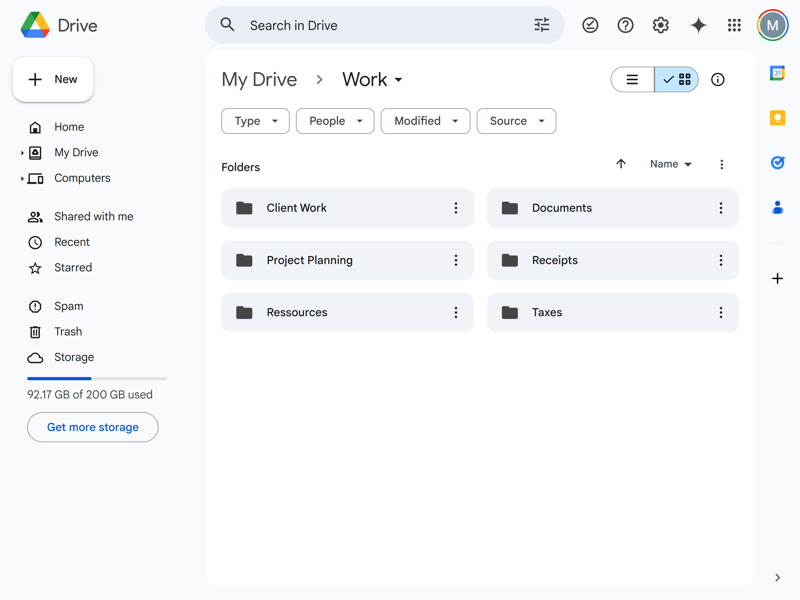
Google Drive is as easy to use as most Google tools.
The web interface is your browser gateway to your cloud storage. Here you can directly access and edit your files on the cloud server or create new Docs, Sheets, Slides and other files. All you need is an internet connection and access to your Google account.
The web interface has a user-friendly layout with several sections:
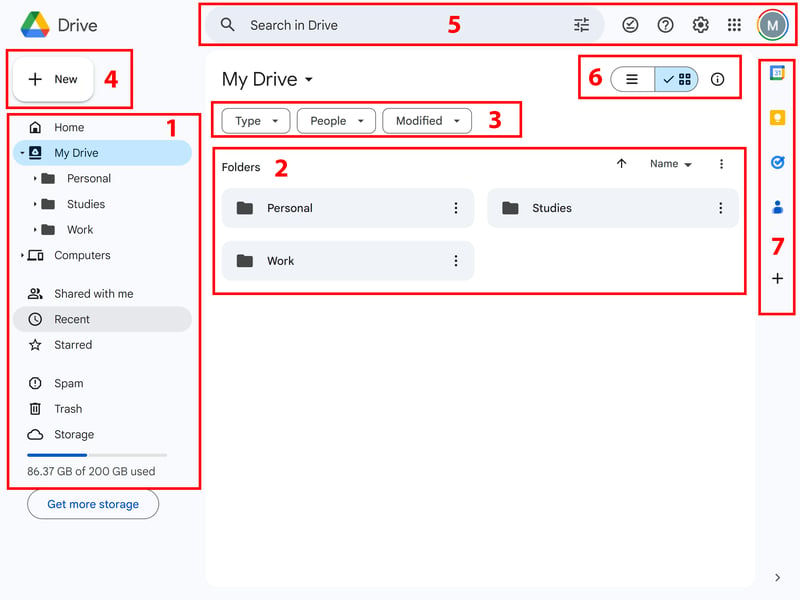
The Google Drive web interface.
- 1.
Main Menu: Navigate through different areas of your cloud storage. The home page shows important folders and files, while My Drive contains all your folders. You'll also find a trash bin and spam folder.
- 2.
Folders: The middle section shows the contents of your currently selected folder or section.
- 3.
Filter Bar: Filter your files and folders by type, people, or date modified.
- 4.
"New" Button: Create or upload new files and folders in seconds with this button.
- 5.
Top Bar: Use the search bar in the middle to look through your entire Google Drive for files and folders. It's handy that the search checks both file names and content. Your Google profile and settings are on the right side of the search bar.
- 6.
Change View: Switch between list and grid view here.
- 7.
Quick Access to Apps: The right sidebar gives you quick access to other Google services like Google Calendar, Google Keep, or Google Tasks. Click the plus icon to access add-ons.
The interface is simple and clutter-free by design. Even beginners should find it easy to get started and organize their cloud files.
The big advantage of Google Drive over regular cloud storage is how smoothly it works with Google Workspace. Google's productivity suite includes cloud tools like Google Docs, Sheets, Slides, and other apps that work great together.
Not only can you store your files and documents in the cloud, you can also edit them directly (and with other users), with changes syncing right away. Only Microsoft OneDrive offers similar features.
Windows 10/11, macOS (Big Sur 11.0 or newer)
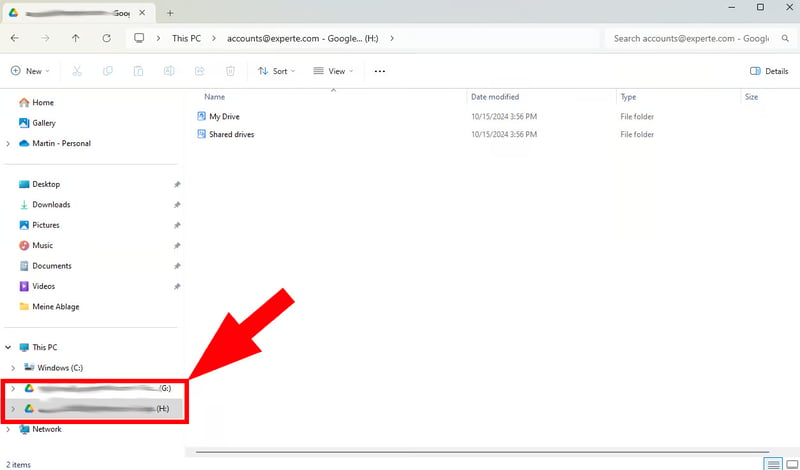
Access your cloud storage through your desktop file manager.
You can access your Google Drive files not just in your browser, but also directly through your computer's file manager. You'll need the Google Drive desktop app for this. It keeps your cloud files in sync across all your devices.
Your Google Drive shows up in Windows Explorer just like a regular hard drive. You can open it and work with the files and folders using all the file manager's tools.
There isn't a proper desktop app, and the settings are somewhat limited. Google Drive Desktop is more like a sync tool that runs in the background.
Android, iOS
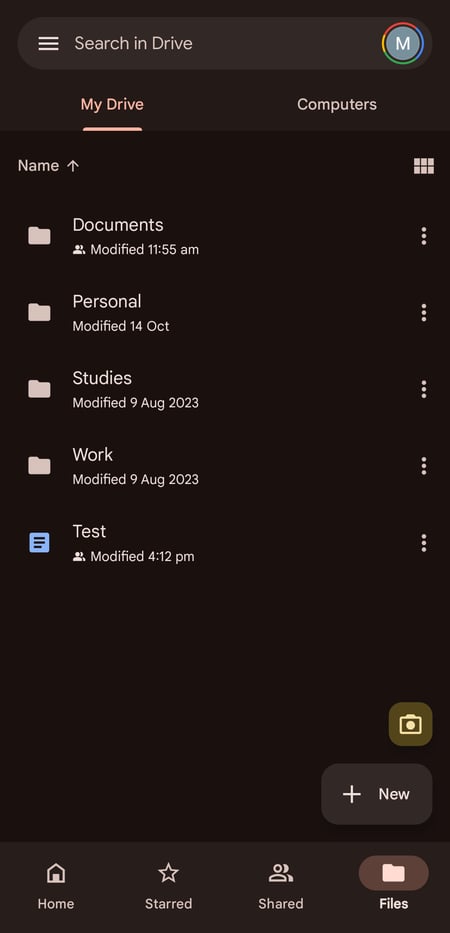
The Drive app comes pre-installed on Android devices.
You can take your Google Drive with you everywhere in your pocket or purse. The smartphone app, available for Android and iOS devices, is just as simple and straightforward as the web interface.
The scan feature is especially handy: Just tap the camera icon to take pictures of documents and save the scans directly to the right folder in your Google Drive.
Here's an overview of all platforms where Google Drive is available:
| Google Drive | Tresorit | pCloud | MEGA | Icedrive | STRATO | IONOS | Dropbox | Sync.com | Microsoft OneDrive | Proton | |
|---|---|---|---|---|---|---|---|---|---|---|---|
| Desktop | |||||||||||
| Windows 7/8 | ✗ | ✓ | ✓ | ✓ | ✓ | ✓ | ✓ | ✗ | ✗ | ✗ | ✗ |
| Windows 10/11 | ✓ | ✓ | ✓ | ✓ | ✓ | ✓ | ✓ | ✓ | ✓ | ✓ | ✓ |
| macOS (Intel) | ✓ | ✓ | ✓ | ✓ | ✓ | ✓ | ✓ | ✓ | ✓ | ✓ | ✗ |
| macOS (Apple Silicon) | ✓ | ✓ | ✓ | ✓ | ✓ | ✓ | ✓ | ✓ | ✓ | ✓ | ✓ |
| Linux | ✗ | ✓ | ✓ | ✓ | ✓ | ✗ | ✗ | ✓ | ✗ | ✗ | ✗ |
| Mobile | |||||||||||
| iOS | ✓ | ✓ | ✓ | ✓ | ✓ | ✓ | ✓ | ✓ | ✓ | ✓ | ✓ |
| Android | ✓ | ✓ | ✓ | ✓ | ✓ | ✓ | ✓ | ✓ | ✓ | ✓ | ✓ |
| Total | 5 | 7 | 7 | 7 | 7 | 6 | 6 | 6 | 5 | 5 | 4 |
Google Drive stands out with its user-friendly, clean interface and smooth integration across all devices - whether in your browser, on desktop, or on the go with the app.
Thanks to its easy-to-use design, users of all skill levels, from beginners to power users, can quickly get started and work smoothly.
With its cloud solution, Google successfully balances simplicity and features - which is exactly what we'd expect from the tech giant.
Storing & Syncing Files
| Synchronization |
| 2/5 |
| Performance |
| 7/10 |
Let's start with Google Drive's basic sync approach: The service uses a "master folder" system. This means all files are organized within one main folder, your "Google Drive" folder. Any changes you make to files in this folder sync automatically and in real-time with the cloud.
When you work in the web app, you're editing files directly in the cloud. This means changes sync right away and are shared across all your devices.
2 Desktop Sync Methods
On desktop, you can choose between two sync methods in the settings:
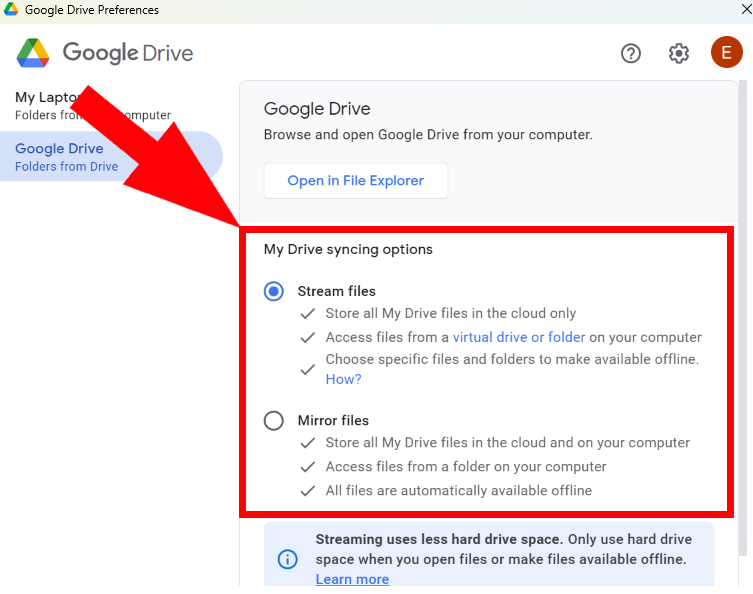
You can make files available only in the cloud or download them to your device.
- 1.
Stream files: When you choose this method, files in your storage are only saved in the cloud by default and streamed to your device when needed. This saves storage space on your device but requires an internet connection for access - unless you set specific folders or files to be available offline.
- 2.
Mirror files: When you mirror your cloud files, they're available offline. However, they take up storage space on your device. Changes sync when you're back online.
Offline Access on All Devices
Speaking of offline access: It's not just available through the "mirror files" method. Even when you choose streaming sync, you can make selected files and folders available offline. Just right-click them and select "Make available offline" under "Offline access."
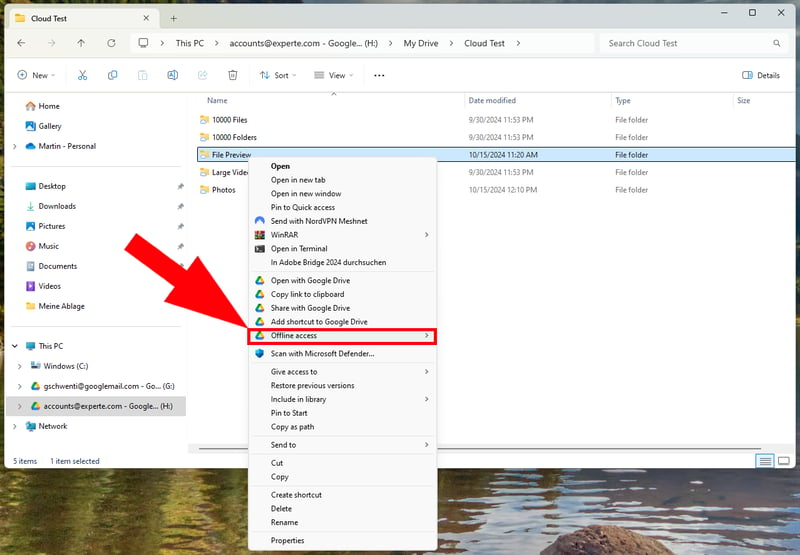
You can enable offline access for individual folders or files.
Offline access options are also available on smartphones and even in the web app. However, web access only works with Google Chrome and Microsoft Edge browsers.
System Folder Backup
You can sync more than just files in your Google Drive folder. You can also back up your PC's system folders to cloud storage.
You can select folders in the desktop app settings or simply right-click them in the file manager and choose "Sync or back up this folder."
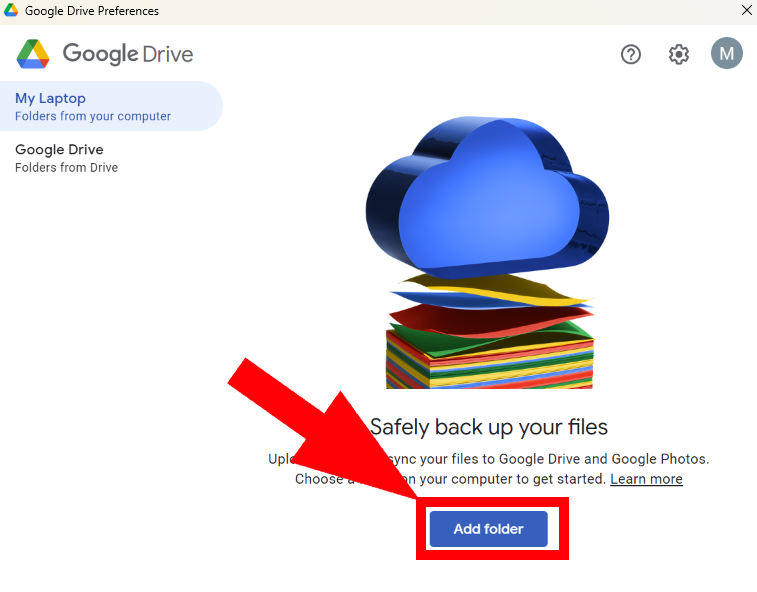
Google Drive also supports backups of local folders.
Limited Flexibility: Few Advanced Settings
Google has included all the basic sync features and made them easy to use. However, some advanced features that would give you more control over syncing are missing.
You can't selectively sync files anymore - meaning you can't choose specific files or folders to exclude from syncing. You also can't transfer files over LAN between two devices on the same network.
Google doesn't let you set upload and download speed limits either. This would be helpful when you have slow internet and want to better manage your network usage.
Here's a comparison of Google Drive's sync features:
| Google Drive | Dropbox | pCloud | MEGA | Tresorit | Microsoft OneDrive | Icedrive | Sync.com | STRATO | Proton | IONOS | |
|---|---|---|---|---|---|---|---|---|---|---|---|
| Selective Sync | ✗ | ✓ | ✓ | ✓ | ✓ | ✗ | ✓ | ✓ | ✓ | ✗ | ✓ |
| Online Mode | ✓ | ✓ | ✓ | ✓ | ✓ | ✓ | ✓ | ✓ | ✗ | ✓ | ✗ |
| Back up System Folders | ✓ | ✓ | ✗ | ✓ | ✗ | ✓ | ✓ | ✗ | ✗ | ✗ | ✗ |
| LAN Sync | ✗ | ✓ | ✓ | ✗ | ✗ | ✗ | ✗ | ✗ | ✗ | ✗ | ✗ |
| Limit Speed | ✗ | ✓ | ✓ | ✓ | ✓ | ✓ | ✗ | ✗ | ✗ | ✗ | ✗ |
| Total | 2 | 5 | 4 | 4 | 3 | 3 | 3 | 2 | 1 | 1 | 1 |
Good Performance and Speed
When it comes to cloud storage performance, two things matter most:
- 1.
How fast files upload and download during syncing? Faster sync speeds make it easier to work across different devices.
- 2.
How much does it affect system performance? Syncing should run quietly in the background using minimal resources, so you can keep working without interruption.
To compare the performance of the cloud storage services in our review, we tested them all under the same conditions. We created a test folder with 10,000 files, 10,000 folders, 100 photos (about 500 MB), and one large video file (about 500 MB), then synced it using a PC with a 400 Mbps connection (upload and download).
Here are the results:
| Upload | Download | CPU Usage | |
|---|---|---|---|
| MEGA | 00:09:45 | 00:10:00 | 47 % |
| pCloud | 00:10:00 | 00:04:30 | 31 % |
| Microsoft OneDrive | 00:25:00 | 00:11:30 | 34 % |
| Google Drive | 00:27:30 | 00:18:45 | 43 % |
| Dropbox | 00:30:45 | 00:10:00 | 73 % |
| Tresorit | 00:37:00 | 00:13:00 | 31 % |
| Sync.com | 00:38:30 | 00:03:30 | 33 % |
| Icedrive | 00:41:15 | 00:11:45 | 81 % |
| IONOS | 01:17:30 | 00:39:00 | 22 % |
| STRATO | 01:27:30 | 00:41:00 | 23 % |
| Proton | 01:33:45 | 00:35:30 | 27 % |
Google Drive syncs quickly and reliably with a user-friendly approach, letting you access the latest versions of your files across all your devices. On desktop, you can stream your cloud files or make them available offline - and back up system folders that aren't in your Drive.
The speeds are good, though not as fast as MEGA or pCloud. It's missing some advanced sync features like selective sync or bandwidth controls. Google Drive works great for basic, everyday file organization and backup, but it lacks flexibility.
File Sharing and Collaboration
| Share files via link | You can share files via link or email. However, some advanced control mechanisms are missing, such as password protection or expiration dates for links. | 2/5 |
| Share folders with users | It's possible to share entire folders or create shared drives for teams. Sharing is quick and straightforward. | 5/5 |
| Request files | No – only with external apps. | 0/2 |
| Team features | The integration of Google tools like Docs or Sheets ensures seamless real-time collaboration in Google Drive. You can create shared drives, set user roles at the folder and document level, and collaborate with many features - including comments, suggestions, and task assignments - in documents. | 8/8 |
Backing up and syncing your data is just the basic feature of cloud storage - and most services offer pretty much the same thing here (apart from performance). The bigger differences between platforms show up when you look at what you can actually do with your cloud files.
Google has a clear advantage here with its seamless integration of collaboration tools. You can easily share your cloud files with others and work on them together in real-time.
Easy Sharing Through Links and Email
Sharing folders and files is straightforward across all user interfaces. There are two main ways to share resources with others:
- 1.
Share links: You can copy links to your folders and files and share them with others manually. However, people can only open them if they have the right access permissions. If they don't, they can request access.
- 2.
Share settings: Share settings give you more control. You can add people and groups using their email addresses, invite them to documents or folders, and manage their access rights.
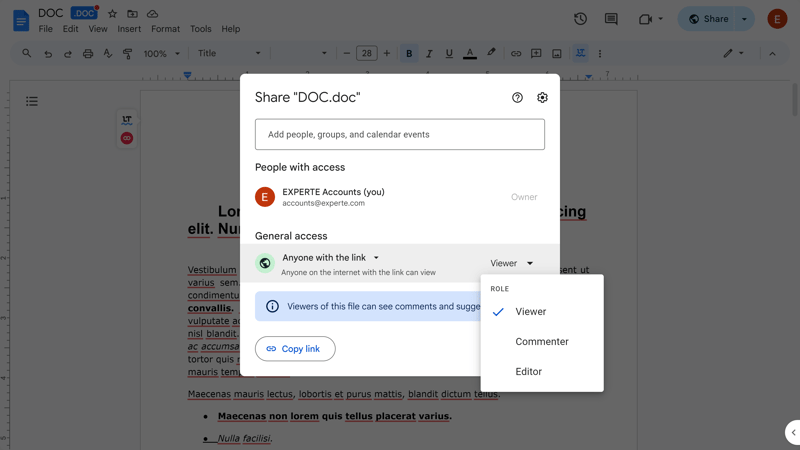
You can share your files and folders with others in just a few clicks.
Unfortunately, the share settings lack some features that are standard in other cloud storage services. For example, you can't protect share links with an extra password. You also can't set an expiration date. These options would be especially helpful when sharing sensitive data with others temporarily or securely.
Google also doesn't provide any statistics for your links - like the number of times they've been accessed or when they were last opened.
Another downside: Google Drive doesn't currently have a built-in way to request files from other users. Many other cloud storage solutions offer upload portals where other people can upload files directly to the cloud storage.
Here's a comparison of Google Drive's main sharing features:
| Google Drive | Tresorit | Sync.com | pCloud | STRATO | Microsoft OneDrive | MEGA | IONOS | Icedrive | Dropbox | Proton | |
|---|---|---|---|---|---|---|---|---|---|---|---|
| Share Files via Link | ✓ | ✓ | ✓ | ✓ | ✓ | ✓ | ✓ | ✓ | ✓ | ✓ | ✓ |
| Password Protected Links | ✗ | ✓ | ✓ | ✓ | ✓ | ✓ | ✓ | ✓ | ✓ | ✓ | ✓ |
| Expiration Date for Links | ✗ | ✓ | ✓ | ✓ | ✓ | ✓ | ✓ | ✓ | ✓ | ✓ | ✓ |
| Statistics for Links | ✗ | ✓ | ✓ | ✓ | ✗ | ✗ | ✗ | ✗ | ✗ | ✗ | ✗ |
| Share Folders With Users | ✓ | ✓ | ✓ | ✓ | ✓ | ✓ | ✓ | ✓ | ✓ | ✓ | ✓ |
| Request Files | ✓ | ✓ | ✓ | ✓ | ✓ | ✓ | ✓ | ✓ | ✓ | ✓ | ✗ |
| Total | 3 | 6 | 6 | 6 | 5 | 5 | 5 | 5 | 5 | 5 | 4 |
Seamless Real-Time Collaboration
As expected, Google shows its biggest strength in collaboration features. This is mainly due to how well Google apps like Docs, Sheets, and Calendar work together.
You can edit Google files - as well as compatible documents like Word or PowerPoint files - directly in your Drive and work on them with other users in real time.
The options are extensive: You can leave comments, make suggestions, assign tasks to other users, and much more. Documents are versioned, so you can always see who changed what and when. You can even start a video meeting or chat with your collaborators directly within a document
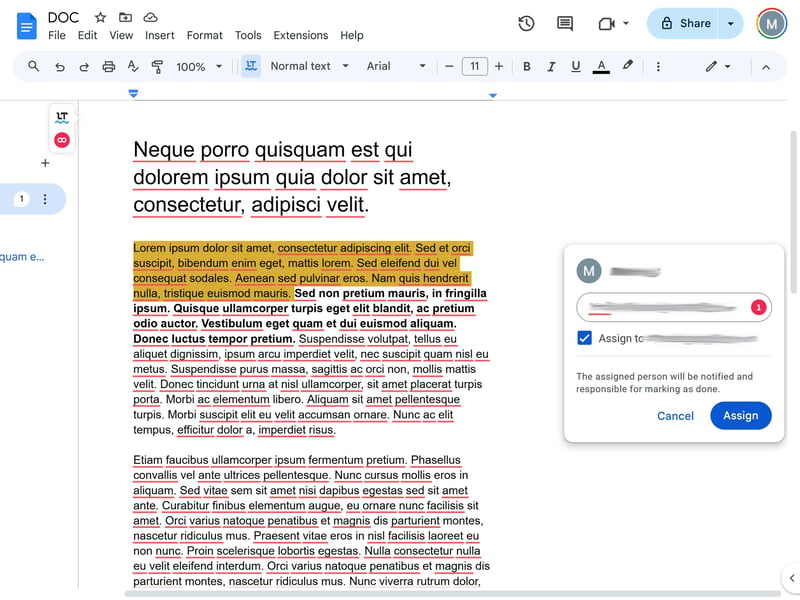
Google stands out with its versatile collaboration features.
If you often work with regular teams, you can create "shared drives" where content is available to all members. In the member management, you can add new groups and individual members and manage their permissions. There are 5 roles:
- 1.
Only administrators can manage members and settings of the shared drive.
- 2.
Content managers can add, edit, move, delete, and share content.
- 3.
Contributors can add and edit files.
- 4.
Commenters can only leave comments in documents but can't edit them directly.
- 5.
Viewers can only open documents but can't make any changes - including leaving comments.
If a document or folder isn't in a shared drive, you can manually set access roles (viewer, commenter, or editor).

There are several user roles.
Here's a comparison of Google Drive's main team features:
| Google Drive | Microsoft OneDrive | Dropbox | Sync.com | Proton | Tresorit | STRATO | pCloud | MEGA | IONOS | Icedrive | |
|---|---|---|---|---|---|---|---|---|---|---|---|
| Team Management | ✓ | ✓ | ✓ | ✓ | ✗ | ✓ | ✓ | ✓ | ✓ | ✓ | ✗ |
| User Roles / Access Rights | ✓ | ✓ | ✓ | ✓ | ✓ | ✓ | ✓ | ✓ | ✓ | ✓ | ✗ |
| Comments | ✓ | ✓ | ✓ | ✓ | ✓ | ✗ | ✗ | ✗ | ✗ | ✗ | ✓ |
| Edit Documents | ✓ | ✓ | ✓ | ✗ | ✓ | ✗ | ✗ | ✗ | ✗ | ✗ | ✗ |
| Total | 4 | 4 | 4 | 3 | 3 | 2 | 2 | 2 | 2 | 2 | 1 |
Google Drive shows that modern cloud storage can do much more than just back up and sync data. The smooth integration with Google tools like Docs, Sheets, and Calendar enables highly dynamic real-time collaboration.
Google Drive is more of a collaboration platform with cloud storage than a cloud storage service with collaboration features. While it lacks some advanced control features, like password protection for links, Google is still one of the best options for productive team collaboration in the cloud.
Security & Privacy
| End-to-end encryption | No – Google has the right to scan and delete data in Google Drive. | 0/10 |
| Security assessment | Google provides good protection against external access but does not offer end-to-end encryption. Therefore, Google potentially has access to the contents of your cloud storage, which limits your privacy. | 2/5 |
| File versioning | Yes, in all plans. | 3/3 |
| Two-factor authentication | Yes | 2/2 |
| GDPR-compliant | According to the provider, yes – but the company's headquarters in the USA and Google's access rights make GDPR-compliant use more complicated than with other cloud storage providers. | 1/2 |
| ISO Certification |
| 2/2 |
| Transparency reports | Google has a comprehensive transparency report. | 2/2 |
| Jurisdiction | Headquarters in the USA | 0/2 |
How safe your data is with Google depends on who you want to protect it from. Google Drive is quite secure when it comes to blocking unauthorized outside access. However, if you're looking for cloud storage that protects your content from the provider itself, Google isn't your best choice.
Strong Protection Against External Threats
Google Drive offers solid protection against attacks and unauthorized access. Google's data centers meet high security standards, are spread across different locations, and have all important security certifications.
According to Google, data you upload to Google Drive is "encrypted during transfer and storage using AES256-bit encryption."
To protect yourself against password theft, you should turn on two-factor authentication. You have several options for the second factor, like passkeys or authentication through an authenticator app.
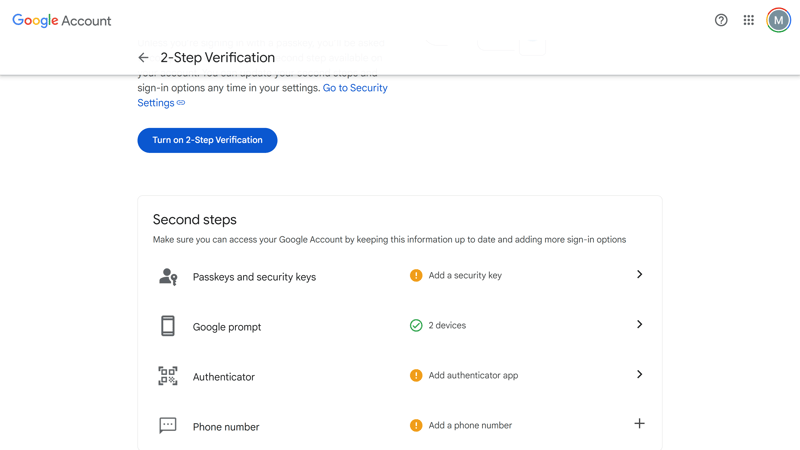
Protect your account with 2FA.
Google's security setup is just as good as its main competitor Microsoft. However, unlike Microsoft's OneDrive, Google Drive doesn't offer a password-protected vault for storing sensitive files - which would add an extra layer of security in case someone gains unauthorized access.
No End-to-End Encryption: Google Has Access
While Google Drive protects your data well against external attackers, it's less secure from Google itself. Unlike providers like MEGA or Proton Drive, which offer end-to-end encryption (E2E), Google can technically access your data.
Though the content is stored in encrypted form, Google holds the encryption keys. This means Google can access your data (within legal limits), for example, when requested by government agencies. Google explains the reasons and legal basis for these accesses in more detail in its Privacy Policy.
Google stresses that content stored in Google Drive is secure and encrypted during transfer and storage. However, Google reserves the right to analyze data to improve its services.

Google Drive's privacy policy.
This can include using data to train AI models. Google's terms of service and privacy policies mention that they collect and process information to offer personalized services and optimize features.
At least Google provides a detailed Transparency Report, which shows how many data disclosure requests they receive from authorities.
Still, if data privacy is important to you, Google Drive - like its competitor Microsoft OneDrive - isn't your best choice. If you want cloud storage that keeps your data private even from the provider, pick a service with E2E encryption instead.
Google claims you can use their cloud tools in line with GDPR rules. However, Google raises more GDPR concerns than other cloud storage services, especially those based in the EU.
Besides the questionable access rights, Google's US headquarters poses another potential risk. As a US company, Google mainly stores data in US data centers. US laws like the Cloud Act let law enforcement access data stored by US companies, even outside the US.
If you use Google Drive for your business, you need to make sure company and user data are properly protected, and clearly explain data handling in your privacy policy. It's best to get professional advice on this.
Here's how Google Drive's privacy features compare:
| Google Drive | Tresorit | Proton | Dropbox | Microsoft OneDrive | MEGA | STRATO | pCloud | IONOS | Icedrive | Sync.com | |
|---|---|---|---|---|---|---|---|---|---|---|---|
| Security | |||||||||||
| End-To-End Encryption Possible | ✗ | ✓ | ✓ | ✓ | ✗ | ✓ | ✓ | ✓ | ✓ | ✓ | ✗ |
| E2E Encryption by Default | ✗ | ✓ | ✓ | ✗ | ✗ | ✓ | ✗ | ✗ | ✗ | ✗ | ✗ |
| Two Factor Authentication | ✓ | ✓ | ✓ | ✓ | ✓ | ✓ | ✓ | ✓ | ✓ | ✓ | ✓ |
| File Versioning | ✓ | ✓ | ✓ | ✓ | ✓ | ✓ | ✓ | ✓ | ✓ | ✓ | ✓ |
| Data Protection | |||||||||||
| GDPR Compliant | ✓ | ✓ | ✓ | ✓ | ✓ | ✓ | ✓ | ✓ | ✓ | ✓ | ✓ |
| ISO 27001 Certification | ✓ | ✓ | ✓ | ✓ | ✓ | ✗ | ✓ | ✓ | ✓ | ✗ | ✗ |
| ISO 27018 Certification | ✓ | ✓ | ✗ | ✓ | ✓ | ✗ | ✗ | ✗ | ✗ | ✗ | ✗ |
| Transparency Reports | ✓ | ✓ | ✓ | ✓ | ✓ | ✓ | ✗ | ✗ | ✗ | ✗ | ✗ |
| Jurisdiction | USA | Switzerland | Switzerland | USA | USA | New Zealand | Germany | Switzerland | Germany | UK | Canada |
| Total | 6 | 8 | 7 | 7 | 6 | 6 | 5 | 5 | 5 | 4 | 3 |
Google Drive offers strong security measures against external threats: Your data is encrypted during transfer and storage, two-factor authentication protects against password theft, and Google's data centers meet high security standards.
However, Google Drive doesn't use end-to-end encryption, which means Google can potentially access your data to improve their services or comply with legal requirements. If you want true privacy in the cloud, you're better off with providers that offer end-to-end encryption.
Pricing
| Free (GB) | 15 GB | 8/8 |
| Price 100 GB | $1.67 | 2/2 |
| Price 500 GB | $8.33 | 1/2 |
| Price 2 TB | $8.33 | 2/2 |
| Price 5 TB | no suitable plan | 0/2 |
| Price for 3 users | $1.67 | 2/2 |
| Price for 10 users | $60 | 1/2 |
Google is generally quite cheap and generous with free storage.
For individual users, there are three plans you can subscribe to either monthly or annually with a discount:
Free: Every Google user gets 15 GB of free storage. That's quite a lot - but keep in mind this storage is shared with your emails and photos.
Basic: The Basic plan gives you 100 GB of storage that you can share with up to five other people.
Premium: The Premium plan offers 2TB of storage, which you can also share with up to five people. You'll also get access to premium features in Google Calendar and Google Meet.
If you want to use Google Drive for your team, you'll need to sign up for a Google Workspace plan, which is billed per user per month. All plans include custom email addresses for your domain and many other Google tools.
There are three regular plans:
Business Starter: The Starter package gives you 30 GB per user. You can host video meetings with up to 100 people.
Business Standard: You get 2 TB storage per user and can host video meetings with up to 150 people. You also unlock advanced features like video call recording and appointment scheduling pages in Calendar.
Business Plus: Along with 5 TB of storage and video meetings for up to 500 people, you get advanced security and management features (like enhanced endpoint management).
For businesses with special needs, there's an Enterprise plan. But you'll need to contact Google's sales team to get a quote.
Here's an overview of the plans:
| Free | One Basic | Business Starter | |
|---|---|---|---|
| Monthly Price | $0.00 | from $1.67 | from $6.00 |
| Contract Period (Months) | 0 | 1 - 12 | 1 - 12 |
| Limits | |||
| Storage Space | 15 GB | 100 GB | 30 GB |
| Number of Users | 1 | 5 | unlimited |
| Number of Devices | unlimited | unlimited | unlimited |
| Max. File Size | 15 GB | 100 GB | 5,000 GB |
| End-to-End Encryption | ✗ | ✗ | ✗ |
| File Versioning | 30 days | 30 days | 30 days |
How does Google compare to other providers in terms of pricing? Pretty well, as our price comparison table shows. For free storage, only MEGA offers more space, and the Basic plan is among the cheapest on the market. If 100 GB is enough for you, Google is a budget-friendly choice.
The 2 TB price is also relatively cheap - but there's no "medium-sized" plan in between. If you only need 500 GB or 1 TB of storage space, you can find better deals elsewhere.
Here's a comparison of costs from different providers for various storage sizes and number of users:
| Free | Price 100 GB | Price 500 GB | Price 2 TB | Price 3 TB | Price 3 Users | Price 10 Users | |
|---|---|---|---|---|---|---|---|
| MEGA | 20 GB | $8.33 | $8.33 | $8.33 | $16.67 | $15.00 | $50.00 |
| Google Drive | 15 GB | $1.67 | $8.33 | $8.33 | $1.67 | $57.50 | |
| pCloud | 10 GB | $4.17 | $4.17 | $8.33 | $49.58 | $23.97 | $55.93 |
| Icedrive | 10 GB | $3.99 | $5.99 | $10.99 | $49.96 | ||
| Sync.com | 5 GB | $4.76 | $7.21 | $7.21 | $18.02 | $16.22 | $54.05 |
| Proton | 5 GB | $3.99 | $9.99 | $23.99 | $23.99 | $83.89 | |
| Microsoft OneDrive | 5 GB | $1.67 | $5.59 | $15.75 | $8.25 | $55.93 | |
| Tresorit | 3 GB | $9.99 | $9.99 | $48.00 | $48.00 | $160.00 | |
| Dropbox | 2 GB | $9.99 | $9.99 | $9.99 | $54.00 | $16.99 | $120.00 |
| STRATO | 0 GB | $2.75 | $2.75 | $9.58 | $47.92 | $11.98 | $22.00 |
| IONOS | 0 GB | $1.50 | $3.85 | $15.00 | $3.00 | $15.00 |
When it comes to cost per GB, Google Drive is really affordable compared to other providers - and that's not all: Google is also among the top providers for free storage. If you're looking for free or low-cost cloud storage, Google is a solid choice.
Review Results
Google solutions rarely stand alone - and Google Drive really shines when used with other Google tools. You can not only store your data in the cloud and access it across devices, but also work on it in real-time with others thanks to smooth integration with Docs, Sheets, Calendar, Meet, and more.
Even as a "pure" storage solution, Google Drive is well-positioned, especially since its storage is relatively affordable and comes with a generous free plan.
However, if you're serious about data privacy, Google isn't your best choice: Without end-to-end encryption, Google has the key to your data – just like Microsoft does. If you're looking for cloud storage that protects your data not only from others but also from the provider itself, you should choose a solution with E2E encryption.
For everyone else who needs a simple and budget-friendly solution for everyday work, Google Drive remains one of the best options – especially if you're already using other Google products.

User Experience
What do Google Drive users think about the service? We've looked through review sites and gathered common feedback:
User-friendly with helpful integrations
Many customers praise Google Drive's easy-to-use interface and smooth integration with other Google tools like Google Docs and Google Sheets.Affordable pricing
Several reviewers highlight the low prices and generous free storage for all Google users.Flexible access and file sharing
Users appreciate how quick and easy it is to share files with others. They also like the offline access and simple cross-device use.
Limited flexibility
Some users find Google Drive not flexible enough, especially for organizing files. For example, it doesn't support color-coding documents.Confusing Windows client structure
Some users find the Windows app frustrating and hard to navigate – partly because Google keeps making changes to it.
Alternatives
Looking for something different than Google Drive? Check out these alternatives:
More secure than Google Drive
Need cloud storage with end-to-end encryption that keeps your data private even from the provider? Take a look at MEGA, Proton Drive, Tresorit, or Icedrive. They all offer E2E encryption with every plan.Cheaper than Google Drive
While Google Drive is already one of the most affordable options out there, MEGA offers more free storage (20 GB). For better value at 500 GB, check out Microsoft OneDrive.
Here are the best Google Drive alternatives:


















